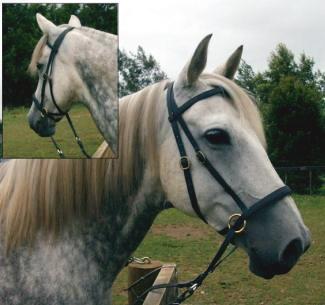

|
A r t i c l e s A n d C a s e
S t u d i e s
BITLESS AND FANCY-FREE
Problems with head tossing? Gags no longer effective with your horse? Teresa Ramsey explores the effects of the bit and the possibility of going without that metal in the mouth . . .
For thousands of years humans have used a piece of metal in the horse's mouth to control it. But it's not until recently that scientific research has demonstrated that even a correctly used bit is damaging to the horse physically and psychologically, as well as reducing performance.
Fortunately, an alternative to the bitted bridle that is more humane and less damaging to the horse is now becoming popular, resulting in optimal performance and increased safety for the rider.
The cross-over Bitless Bridle is now in many cases successfully replacing not only the common snaffle, but the more severe bits previously used as a last resort to control problem horses.
Matamata Saddlery owner Ian Lipscombe has recommended the crossover bitless bridle to customers who have come to him at their wits end when severe bits such as dutch gags no longer worked to control their horses.
After some skepticism, these customers tried the bitless bridle to find they have more control of their horse than the most severe of bits. Horse's previously bolting or out of control when ridden with a bit are easily stopped and turned when using the bitless bridle.
''If people just try to think from the horse's point of view: they go from a snaffle and into a dutch gag, why? Because you're causing the horse more pain,'' Mr Lipscombe says.
''I think it makes perfect sense, a Bitless Bridle enables you to ride the horse without pain.''

Hunter Penny Gifford, of Te Aroha, has been riding in a bitless bridle for just under a year. After reading about them on the internet, Penny asked Matamata Saddlery to make one for her for the 2003 hunt season, during which she hunted her skewbald hunter in the bitless bridle twice a week.
''To begin with, I was a bit concerned about going bitless on a hunt field. For the first day, I took my bitted bridle in my saddle bag. Turns out I never needed it and haven't taken it since. I have just as much control in a bitless bridle, and my horse performs better bitless,'' Ms Gifford says.
Since then, Ms Gifford's ex-racehorse has been showjumping up to 90cm and competing in cross-country in the bitless bridle and the horse turns and stops effortlessly. This horse previously had problems with severe head tossing, which he rarely does when being ridden in the bitless bridle.
Why Go Bitless?
''That the presence of the bit is harmful to the horse in the hands of an inexperienced or unskilled rider has never been disputed. That its invasive presence in a sensitive body cavity has detrimental effects even if the rider never touches the reins is a somewhat more recent discovery.''
- 'The Centaur Reborn' by Peter Speckmaier and Sabine Kells
There is now hard scientific evidence demonstrating the harmful effects of the bit, whether used correctly or not. Horse's do not cry out in pain like dogs or pigs do. Rather, as a flight animal, the horse's survival strategy is to keep quiet and run from pain if they can.
In his book ''Metal in the Mouth, The Abusive Effects of Bitted Bridles'' Dr Robert Cook says visible clinical evidence for the existence of bit-induced pain in the horse is more psychological than physical.
''There are no externally visible signs such as those caused by inflammation (for example, redness, swelling, and heat), though a careful palpation of the bars of the mouth in the live horse may reveal the presence of small but excruciatingly painful bone spurs. The more obvious signs of pain in the horse are expressed by changes in its behaviour. Pain from the bit (an aching jaw) is expressed predominantly by various manifestations of fear.''
Effects of the Bit
Cook says fear can be recognised in the horse by fright, flight, fight, or freeze. Under each of these divisions contains many different expressions of pain, the horse may express up to 95 signs of aversion to the bit according to Cook.
These include head shaking/tossing/flipping the nose at exercise or rest (facial neuralgia or pain along the course of a nerve); management problems prior to riding; bucking, spinning, rearing, 'star gazing', behind the bit; laziness, dullness; lack of progress; refusal; backing, fidgeting, barn sour, unco-operative, anxiousness, crossing the jaw . . . the list goes on.
Cook's research showed that an average of 23 of these problems existed in his study. On average, more than two thirds of these problems were eliminated in seven weeks, simply by removing one or more bits from the horse's mouth.
Bone Damage. The bit applies pressure to the top edge of the lower jaw, what is known as the bars of the mouth. As a veterinarian with 50 years of research into the diseases of the mouth, ear, nose and throat of the horse, Cook discovered that the forces of the bit in the horses mouth damage the gum, which can result in bone spurs or in more serious cases, sections of the bone dying and being sloughed away.
Cook's research demonstrated that bone spurs on the bars were present on more than 74% of horses in his study.
Impairs Breathing. The bit seriously interferes with breathing during hard exercise. As the horse is an entirely nose-breathing animal and cannot breath through its mouth, it can only either eat or exercise at one time to avoid food getting switched into the lungs. The bit in it's mouth switches on the horse's digestive system, which is contradictory for the horse as the rider is asking it to exercise, which would require it's respiratory system to be functioning.
''Which reflex should be obeyed? The one that says 'there is something in the mouth, saliva should flow, swallowing will follow, close the airway and open the food passage!' . . . or the one that says 'increased oxygen is needed to fuel muscle action, open the airway wide and close the food passage!','' Cook says. '' The panic responses of fight or flight are not what a rider needs.''
With a bit, the horse's breathing is impaired which results in reduced oxygen to the organism, needed for the skeletal muscle or heart muscle to function optimally. Without a bit, a horse while exercising has it's lips sealed, mouth closed and no air can creep into the back of the mouth.
Different Types of Bits
According to the book, 'The Centaur Reborn' by Peter Speckmaier and Sabine Kells, the joint of a single-broken snaffle, often believed to be the gentlest bit, applies pressure to the roof of the horse's mouth causing scarring. The double-broken bit (eg French snaffle), does not scar the roof of the mouth but applies more force on the jaw bone than a single-broken bit.
Straight curb bits apply more force on the horse's mouth, curbs with a port allow more room for the tongue but more force is applied to the bars of the mouth. Rubber bits, thought to be soft, are sometimes so thick that when combined with a noseband to tie shut the mouth, the horse's teeth don't meet due to the thickness of the bit.
''Probably one of the 'easiest' bits on the horse is the mullen mouth snaffle: an unbroken bit with slight curvature (port) that gives some room for the tongue but doesn't put too much pressure on the gums. However, here too, the adverse physiological effects of the bit remain,'' Speckmaier and Kells say.

How The Cross-Over Bitless Bridle Works
The crossover bitless bridle is probably the most humane bridle a rider can use. Unlike other bitless bridles, such as hackamores, bosals, and sidepulls, the crossover Bitless Bridle is an entirely painless method of communication that enables both stopping and steering.
''Hackamores and bosals provide for stopping but are weak on steering, whereas sidepulls provide for steering but are weak on stopping. The crossover bridle provides for stopping by hugging the whole of the head, and steers by nudging one half of the head,'' Cook says.
The earliest intimation of the crossover principle can be traced back to a halter depicted on a Greek vase dating back to the 5th century BC. The crossover Bitless Bridle which has recently become popular, has two straps that cross each other above the horse's chin, then pass through two rings on the side of the bridle.
To steer a horse, light tension on one rein distributes even lighter pressure on the whole of the opposite half of the head, from poll to chin, and across the bridge of the nose. To stop a horse, pressure applied on both reins activates a whole-head hug.
''If you place your fingers under the crossover strap on the right side and apply tension to the left rein, your fingers will register a gentle squeeze,'' Cook says.
''When you are steering a horse to the left, instead of pulling painfully on the mouth, you are gently nudging the right side of the head,. Horses respond better to being pushed than pulled. So you communicate with you horse painlessly and the horse steers more willingly. The horse also moves its head in a more natural manner, keeping its head upright and without any of the tilting that the bit tends to cause.''
Dr Cook says the crossover Bitless Bridle has already been used in most disciplines and is applicable to all disciplines, riders, breeds and types of horse.
''The crossover bridle works by improving the welfare of the horse and contributing to the safety and satisfaction of the rider. The likelihood of accidents is reduced and performance is enhanced.''
Fitting and Using the Bitless Bridle
The bridle fits like a normal bridle, with the straps crossing over each other
under the horse's head. The nose piece should sit no higher than two finger's
width below the horse's cheek bones and no lower than the soft cartilage of the
horse's nose. Bridles are available made to measure, contact Natural Hoof for
more information.
It is advisable to use the bitless bridle for the first few rides in an
enclosed area, making lots of turns and stops so that your horse gets used to
the new feel of the bridle.
For more information about fitting and using the bitless bridle, download our
Bitless Bridle User Information Manual Requires Acrobat Reader
Resources:
''Metal in the Mouth, The Abusive Effects of Bitted Bridles'' Dr Robert Cook
'The Centaur Reborn' by Peter Speckmaier and Sabine Kells
Dr Cook's website: www.bitlessbridle.com
Bitless Bridles for sale in New Zealand: www.naturalhoof.co.nz
or Phone New Zealand 07 862 7077 (bus)
Bitless Bridles are available in black or brown, made from
biothane or quality hand-stitched English leather.
©All articles and parts of this website are
Copyright of Natural Hoof. If you would like to use any articles or any part of
this website, please contact Natural Hoof for permission.
Disclaimer: Natural Hoof
reserves the right to change or edit any part of
all articles and case studies submitted to this
website. Natural Hoof does not take any
responsibility for the content of any articles
and/or case studies and/or any misapplication of the information presented in any articles. Natural Hoof presumes readers consult a professional for more information about any topic covered in any Natural Hoof article.
Home | Articles | Study Groups | Clinics-Events | Brag | Classifieds |
Order | Links


email: info@naturalhoof.co.nz
|
|
Download our
Bitless Bridle User Information Manual
Requires Acrobat Reader

Bitless Bridles
Now available in NZ
Visit our online shop for more info
|





